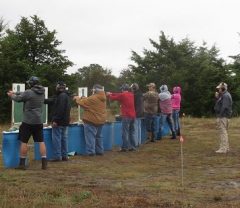by Sandy Keathley
McKinney Firearms Training.com
While it might not seem that this is a suitable topic for a blog on shooting tips, it actually is. It doesn’t make much sense to practice accurate marksmanship, only to have the gun fail to work in a defensive situation. The issue is not so much the cleaning of carbon from the chamber and bore, but lubricating the moving parts. Revolvers are much less affected by this, but semi-automatics have a delicate balance between the backward force imparted by the cartridge firing, the forward force of the return spring, and the friction in the slide channels. That balance is easily upset, by using a low-powered cartridge, the wrong return spring, or allowing dirt buildup around the slide.
Cleaning kits can be bought inexpensively at all gun stores and outdoors/hunting stores (Cabela’s, Bass Pro, Gander Mountain, etc.), or online. They will generally include solvent, gun oil, patches of various sizes, a T-handle cleaning rod, and a selection of rod ends for pulling patches through the bore. Not included are the brushes (brass or nylon) used for cleaning the bore, as these are caliber-specific, and need to be bought separately.
Revolver. This one is easy. Swab each of the chambers in the cylinder, and the entire bore (barrel) with a patch soaked in solvent. Run the proper-sized brush through each several times, then follow with patches until they no longer show discoloration. Wipe down both ends of the cylinder, and any other places inside the frame you can reach. Revolvers require very little lubrication, but you can put a drop on the ejector rod and one where the cylinder revolves in the yoke.
Semi-auto. These must be broken down a little. The first step, of course, is to remove the magazine and clear the chamber. When you hear that someone said “I was just cleaning my gun, and it went off“, they are lying. They are trying to explain why they shot someone. You can’t run a bore brush through a chamber that has a cartridge in it. Duh! Don’t be an idiot.
The next step requires your manual. If you don’t have one, they can be found online. The process for breaking down the gun is similar for most guns, yet different enough that you should not try it unless you have the manual, or your gun is identical to another with which you are familiar. Once you know the trick for removing the take-down lever (pin), the slide will come off. The main part of the gun can be put aside. Remove the barrel from the slide. You will be cleaning the grooves in the slide, and the inside of the barrel, just like with the revolver. On reassembly, be sure and oil the grooves in which the slide moves. Instead of gun oil, you can also use gun grease; that is just a personal preference.
Once reassembled, rack the slide several times to test the action. If you did anything wrong, you will find out now. If it passes, put it away, and you are now good for another two or three range trips.
